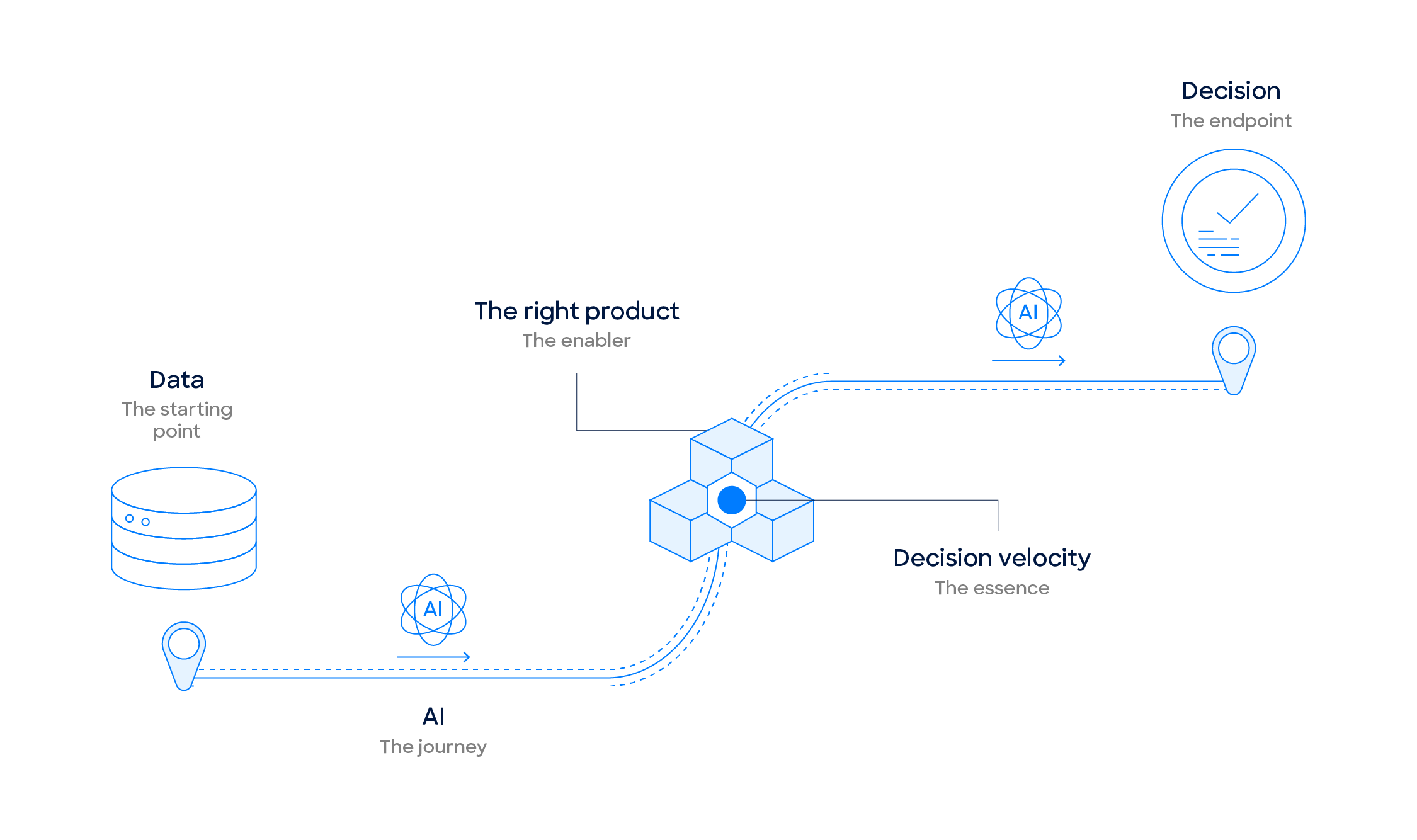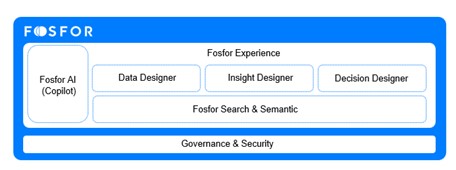 Reading Time: 7 minutes
Reading Time: 7 minutesIntroducing the problem – How enterprises struggle to drive data-led decisions
Enterprises in today’s hyper-competitive market are inundated with overwhelming amounts of data. From customer interactions and transactions to market trends and internal operations, data is woven into the very fabric of business. On the other side, the market is filled with AI products that can turn businesses hyper-productive and creative. In another dimension, businesses have access to a plethora of software products that are loaded with features.
Yet, despite internal data abundance and external abundance of tools and AI, many enterprises find themselves unable to harness the power of data and AI to steer decision-making processes effectively, struggling to drive data-led decisions that can effectively steer business outcomes.
Where does the challenge arise?
Markets have evolved, enterprises have evolved. Yet, it is untrue that all are at advantage. When businesses have too many choices and vast resources, they are only able to maintain the status quo. They constantly harp on the threat of advancing competition.
So, what exactly is the missing link then? The data-to-decisions journey! (refer fig. 1)

The importance of decision velocity in a competitive market
In today’s fast-paced business environment, the speed at which decisions are made—decision velocity—is critical for maintaining a competitive edge. The ability to quickly analyze data and implement decisions can impact an enterprise’s capacity to adapt to market changes and capitalize on emerging opportunities.
The three business conundrums
The data conundrum
Enterprises today collect vast amounts of data, yet they struggle to extract meaningful insights for informed decision-making.
- Data overload: Businesses collect data from various sources, including customer interactions, sales, operations, and marketing campaigns. However, the sheer volume of data can overwhelm decision-makers, leading to analysis paralysis and indecision.
- Complexity and variety: Data comes in diverse formats – structured (databases), semi-structured (logs, social media), and unstructured (text, images).Integrating and analyzing this heterogeneous data requires sophisticated tools and expertise.
- Lack of data literacy: Despite data being abundant, not all employees possess the necessary data literacy skills. Understanding data, interpreting visualizations, and drawing actionable conclusions remain challenges.
- Legacy systems and silos: Many organizations rely on legacy systems that don’t communicate seamlessly. Siloed data prevents a holistic view, hindering effective decision-making.
- Emergence of AI and ML: Artificial Intelligence (AI) and Machine Learning (ML) offer solutions for data analysis. Predictive models, anomaly detection, and natural language processing enhance decision-making.
- Data governance and security: Organizations are recognizing the need for a robust data strategy. Aligning data initiatives with business goals is essential. Ensuring data quality, privacy, and compliance is critical. Organizations must balance data accessibility with security measures.
In summary, while businesses drown in data, the key lies in transforming it into actionable decisions. By fostering data literacy, and leveraging advanced technologies, organizations can navigate this data-rich landscape effectively.
The AI conundrum
The field of Artificial Intelligence (AI) has seen substantial growth globally, with an increasing number of companies entering the market each year. AI is becoming deeply embedded across various industries, leading to a significant rise in the number of companies specializing in AI technologies.
According to Statista, the United States leads the major western economies with around 15,000 AI companies as of 2023. In comparison, the European Union collectively hosts 6,000 AI firms, and the UK alone boasts ~9,000 AI companies. Exploding Topics reports that there are currently around 70,000 AI companies worldwide. A sizeable portion, approximately 25%, is based in the United States, which highlights the country’s dominant position in the AI sector. The AI market is expected to grow significantly in the coming years. It was valued at around $200 billion in 2023 and is anticipated to expand to ~$2 trillion by 2030. This growth spans various applications, including supply chains, marketing, research, and more.
AI funding has seen exponential growth, increasing over sevenfold from $12.75 billion in 2015 to $93.5 billion in 2021. This surge in investment underscores the perceived value and potential of AI technologies across industries. While AI is booming, it also means that businesses need to tread cautiously on using it in the right way.
Over one-third (35%) of companies worldwide are currently using AI. This means approximately 116.67 million companies utilize AI technologies, with 42% of all companies exploring the potential of AI in their operations.
By leveraging AI, businesses can not only maintain a competitive edge but also position themselves as leaders in their respective industries, ready to navigate the complexities and opportunities of the digital age.
While the application of Artificial Intelligence (AI) brings unimaginable benefits, it also introduces a variety of risks that need to be effectively mitigated.
- Bias: AI systems can inadvertently perpetuate biases present in the data they are trained on. Without proper oversight, these biases can lead to discriminatory practices, particularly in sensitive areas such as hiring, lending, and law enforcement.
- Model illiteracy: Many AI models, especially deep learning networks, operate as “black boxes,” making it difficult to understand how decisions are made. This lack of transparency can be a significant risk, particularly in high-stakes industries such as healthcare and finance, where understanding the basis for decisions is critical.
- Vulnerabilities: AI systems can be vulnerable to attacks such as data poisoning, adversarial attacks, and model theft. Such security vulnerabilities can compromise the integrity, confidentiality, and availability of AI systems, leading to severe consequences.
- Privacy concerns: The use of AI often requires large amounts of data, including personal data, which can raise significant privacy issues. Businesses must ensure that their use of AI complies with data protection regulations such as GDPR (General Data Protection Regulation).
- Job losses: AI automation can lead to workforce restructuring and potential job losses. While new jobs will emerge, there is a risk that displaced workers may not have the skills required for new positions.
- Ethical and regulatory issues: Using AI in business can give rise to ethical issues such as accountability, fairness, and unintended consequences. Additionally, the legal landscape for AI is still evolving, which poses regulatory risks.
- Over-dependency: An over-reliance on AI can lead to a loss of human oversight and critical thinking in decision-making processes. Businesses must ensure that human judgment remains a core component of their operations.
It is obvious that businesses find it tricky to counter the cons of AI with its pros. Hence, it is important to maintain a balance between AI automation and human oversight, encouraging human judgment in critical decision-making processes.
The product conundrum
The global software product market is projected to reach $ 698.8 billion in revenue by 2024 while Enterprise Software dominates the market, with a projected volume of $ 292 billion in 2024.
The software market continues to evolve due to increasing demand for digital transformation across industries. Businesses seek software solutions that streamline processes, reduce costs, and improve efficiency. Cloud-based software solutions are gaining popularity for their flexibility, scalability, and cost-effectiveness. Software product(s) companies are heavily loading features into their product, expanding into upstream and downstream capabilities. They have also embraced the era of copilots. Every industry is enjoying the benefit of AI driven software solutions.
- Healthcare : AI-powered diagnostic tools in healthcare assist doctors in identifying diseases more accurately and quickly.
- Financial : Robo-advisors provide investment recommendations based on real-time data analysis.
- Manufacturing : AI copilots monitor production lines in facilities, to detect anomalies and predict equipment failures before they occur.
- Retail : AI enhances customer service through chatbots and virtual shopping assistants that provide personalized recommendations.
These factors confuse businesses on how to buy an effective solution that will help solve their business problems and drive them towards quantifiable decisions.
The proof of the pudding
There is substantial proof that Data and AI are playing a pivotal role across market domains. Here are some good examples.

The essence: Decision velocity
Now that we have understood the three business conundrums – data, AI, and software – any business would needto navigate all the three areas very carefully to maximize value. A decision taken by any enterprise will touch all these areas. Decision velocity- the speed at which a decision is taken, hence, is key for that competitive edge. Is there a product in town, which marries data and AI, with the sole intention of delivering quality decisions?
Enter the Fosfor Decision Cloud
The Fosfor Decision Cloud (refer image 2) is an innovative software product designed to tackle the challenges enterprises face in driving data & AI-led decisions. With powerful AI capabilities, the Fosfor Decision Cloud offers a comprehensive suite of tools that enable organizations to unlock the essence: Decision velocity.


How the Fosfor Decision Cloud improves the decision-making process
Businesses cannot employ the Data- AI- Product loop to every business problem infinitely. Invariably they need to resort to a product that enables them in all these areas. FDC allows solution creation, irrespective of industry or area of business requirement. It is a unified product that optimizes for data, AI and outcomes, has a short learning curve and delivers high ROI. The Fosfor Decision Cloud brings enterprise to the forefront, providing an unparallel competitive advantage
Conclusion: The synchronous process
To achieve a compelling vision, it is essential for multiple teams to work in tandem using a unified technological platform. Whether it is a small business case or a major strategic decision, the Fosfor Decision Cloud enables enterprises to transform data into actionable insights swiftly and intelligently. The data-to-decision journey becomes a pivotal part of the business strategy, rather than an ancillary layer.
In conclusion, the Fosfor Decision Cloud addresses the core challenges that enterprises face in data-led decision-making. Its advanced AI capabilities provide the necessary decision velocity and a competitive edge, ensuring that data becomes a key driver of business success rather than a hindrance.
References
1. AI references
2. AI in insurance market growth- https://www.marketsandmarkets.com/Market-Reports/insurance-analytics-market-224620780.html
3. Retail analytics market forecast- https://www.researchandmarkets.com/reports/4535944/retail-analytics-market-forecast-from-2020-to
4. AI in manufacturing market trends- https://www.marketsandmarkets.com/Market-Reports/artificial-intelligence-manufacturing-market-7267912.html
5. Video streaming market size- https://www.grandviewresearch.com/industry-analysis/video-streaming-market
6. AI in hospitality market growth- https://www.researchandmarkets.com/reports/5327079/global-artificial-intelligence-in-hospitality





